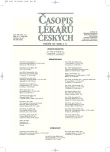Multidisciplinary Use of Contrast Sensitivity
Authors:
J. Krásný
Authors‘ workplace:
Oční klinika FNKV a IPVZ, Praha
Published in:
Čas. Lék. čes. 2006; 145: 865-869
Category:
Original Article
Overview
Background.
Contrast sensitivity (CS) gives information about quality of different spatial frequency sent from sensory cells to the brain cortex through different pathways.
Methods and Results.
From the age of 6 to 10 years average CS threshold was defined for each frequency. 3c/deg=1,82 (SD 0,13), 6 c/deg=2,04 (SD 0,14), 12 c/deg=1,74 (SD 0,15), 18 c/deg=1,29 (SD 0,11). In the age between 11 and 19 years following values were determined: 3c/deg=1,92 (SD 0,09), 6 c/deg=2,19 (SD 0,12), 12 c/deg=1,89 (SD 0,10), 18 c/deg=1,42 (SD 0,12). There was no significant difference between each frequency on CS curve. Average threshold for all frequencies was the 6th contrast level of circle in younger children and the 7th contrast level of circle in older. According to the standard deviations the threshold for all the frequencies was the 5th contrast level of circle in children from 6 to 10 and the 6th contrast level of circle in children older then 11. As the CS can be distorted by hidden form of anisometric amblyopia, proper correction of refractive error is essential. CS helps to detect hidden neuropathy in Graves disease or in Septo-optic dysplasia. Initial stages of demyelinisation of optic nerve in Multiple Sclerosis are manifested always by decrease of CS. This helps to evaluate the affection of the optic pathway and CNS in Alzheimer disease, in Parkinson’s disease and schizophrenia. Decrease of CS goes along with retinopathy and with some forms of preretinopathy in Diabetes mellitus. Dynamic changes of CS can be related to treatment of several diseases including Cystic fibrosis, Chronic renal insufficiency, Neonatal hypothyreosis, Menopause or Osteoporosis.
Conclusions.
Author proves that CS can be reliably examined using the device CSV-1000 in children from the age of 6 years within the framework of multidisciplinary use.
Key words:
anisometropic amblyopia, contrast sensitivity, childhood, diabetes mellitus, norms of spatial frequency, refraction.
Labels
Addictology Allergology and clinical immunology Angiology Audiology Clinical biochemistry Dermatology & STDs Paediatric gastroenterology Paediatric surgery Paediatric cardiology Paediatric neurology Paediatric ENT Paediatric psychiatry Paediatric rheumatology Diabetology Pharmacy Vascular surgery Pain management Dental HygienistArticle was published in
Journal of Czech Physicians

Most read in this issue
- Nicotinic Acid: An Unjustly Neglected Remedy
- Mean Platelet Volume (MPV) in Crohn’s Disease Patients
- Our First Experience with CT Enteroclysis
- Contemporary Non-invasive Aesthetic Medicine
